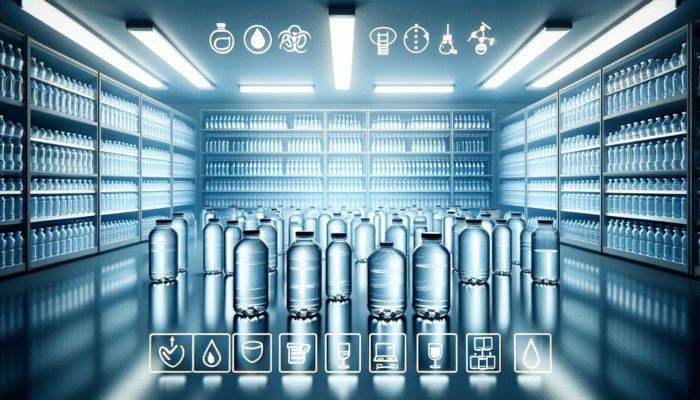Maximizing Community Survival: The Essential Importance of Emergency Water Reserves
Addressing the Critical Necessity for Water Reserves During Emergencies

Emergency water reserves play a vital role in the survival strategies of communities, particularly during crises when access to clean water can become alarmingly scarce. Water is crucial not only for hydration but also for safeguarding public health and sanitation. In the aftermath of devastating events like floods or earthquakes, which can severely disrupt existing water infrastructure, having adequate water reserves can serve as a lifesaving resource for numerous individuals. This necessity extends beyond simple thirst; it is fundamentally tied to preserving health, preventing disease outbreaks, and reinforcing community resilience in dire situations. Access to safe drinking water can immensely influence recovery and survival rates in any impacted area.
When disaster strikes, the immediate instinct of individuals is to find safe drinking water. In urban environments, the limited availability of water can trigger panic, confusion, and chaos. Communities that prioritize the establishment of emergency water reserves can ease this anxiety by ensuring prompt access to potable water. The urgency for such reserves is especially critical in regions prone to natural disasters; however, the global urgency is escalating as the effects of climate change intensify extreme weather events. From the drought-affected areas of sub-Saharan Africa to the flood-inflicted coastal regions of Southeast Asia, one undeniable truth remains: the availability of water is essential for human survival.
Boosting Preparedness with Effective Water Management Strategies
Being prepared is not just a catchphrase; it is a fundamental principle that underlies the protection of health and hygiene during emergencies. Imagine a scenario where a hurricane is poised to strike a coastal town. Those who take the initiative to prepare by stockpiling emergency water reserves can greatly diminish their risk of dehydration and alleviate health crises. As available water supplies dwindle and emergency services become overwhelmed, having reserved water supplies enables individuals to uphold hygiene practices that are vital for preventing the spread of diseases.
The benefits of preparedness extend beyond personal health concerns. Communities that actively advocate for the significance of emergency water reserves can maintain high sanitation standards, thereby diminishing the risk of disease outbreaks such as cholera or typhoid fever, which thrive in unsanitary environments. The proverb “an ounce of prevention is worth a pound of cure” resonates profoundly here. By equipping communities with the essential tools to navigate challenging circumstances, countless lives can be preserved, fostering a culture of resilience and responsibility that encompasses all critical resources.
Fostering Long-Term Security and Stability with Strategic Water Reserves
Long-term security is not merely an abstract goal; it is a tangible outcome for those who recognize the significance of establishing emergency water reserves. These reserves act as a protective barrier against the unpredictable effects of climate change, which includes droughts, floods, and other water-related issues. By investing in strong water storage solutions and methodically developing these reserves, communities not only prepare for immediate emergencies but also lay the groundwork for enduring stability and resilience.
Take note of cities that implement comprehensive water management strategies—they frequently witness a significant decline in economic losses during crises. Agriculture, which serves as the backbone of many economies, flourishes when farmers have dependable access to water, even during drought conditions. This creates a ripple effect that enhances food security, economic stability, and social cohesion. Preparing for possible water shortages is akin to establishing a sustainable future, empowering communities to adapt and flourish amid various challenges.
Exploring Comprehensive and Innovative Water Storage Solutions

Storing water efficiently is not merely about filling containers; it requires a combination of scientific understanding and practical skills. Successful strategies for emergency water reserves must encompass methods that ensure safety, accessibility, and usability. First and foremost, selecting the right storage containers is crucial. Food-grade plastic or glass containers are preferred, as they prevent harmful chemicals from leaching into the water. Additionally, conducting regular inspections and adhering to established disinfection protocols is essential to maintain the integrity of stored water.
Globally, innovative storage solutions are emerging. These include underground cisterns designed to collect rainwater in dry regions and advanced filtration systems that ensure surface water is safe for drinking. For example, in India, community-driven initiatives are actively pursuing rainwater harvesting, creating sustainable methods that help replenish groundwater aquifers. As we explore these strategies, it becomes evident that effective water storage is not just about being prepared; it involves harnessing our collective ingenuity and resourcefulness to guarantee the safety and accessibility of water for everyone.
Promoting Collaborative Efforts Between Communities and Governments in Water Management
Collaboration is the bedrock of sustaining emergency water reserves. It is insufficient for individuals to act in isolation; a collective effort between community members and governmental bodies is vital for establishing effective water management systems. Governments play a crucial role in crafting supportive policies, funding infrastructure initiatives, and fostering active community engagement. When government agencies collaborate with local organizations, transformative results can be achieved.
Consider successful models worldwide, such as the community-oriented water management systems in Sweden. Here, local stakeholders are actively involved in monitoring and maintaining water reserves, cultivating a sense of ownership and accountability. In contrast, regions lacking government support often struggle to establish effective reserves. The lesson is clear: collaboration enhances resources and builds trust and resilience within communities during emergencies.
Diving Into the Various Types of Emergency Water Reserves Available
Understanding the Critical Role of Surface Water Storage in Crisis Situations
Surface water reserves, which include lakes, reservoirs, and ponds, are crucial for supplying communities with emergency water supplies. In situations where natural disasters disrupt normal water supply pathways, these bodies of water can become essential lifelines, provided they undergo adequate treatment before use. For example, in the Amazon rainforest, indigenous communities rely on large rivers as drinking water sources after thorough purification, illustrating how nature can serve as a reservoir in critical times.
Effectively utilizing surface water hinges on proper treatment methods. Technologies such as UV purification and advanced filtration systems are pivotal in ensuring that harvested surface water is safe for consumption. In urban contexts, several cities have adopted stormwater management systems that capture and treat rainwater runoff, transforming potential hazards into valuable resources. The global push for sustainability compels us to think innovatively about harnessing available resources, thereby redefining our relationship with water.
Harnessing the Potential of Groundwater Reserves for Sustainable Utilization
Groundwater is often an underappreciated yet critical resource for providing a reliable water supply during emergencies. Accessed through wells and boreholes, these reserves can furnish essential resources when surface water sources are compromised. Countries like Ethiopia and India have historically relied on groundwater for both agricultural and domestic uses, highlighting its significance in everyday life.
However, accessing this valuable resource requires meticulous management. Over-extraction can lead to depletion, resulting in long-term water shortages. Innovative techniques, such as rainwater harvesting and recharge wells, can aid in replenishing groundwater supplies, ensuring that these reserves remain viable for future emergencies. With a strategic approach, communities around the world can tap into groundwater’s potential to promote sustainability and security.
Highlighting the Importance of Bottled Water Stockpiles in Emergency Preparedness
The convenience and simplicity of bottled water stockpiles make them an essential aspect of emergency water reserves globally. Readily available for immediate use, bottled water is optimal for quick distribution to populations affected by emergencies. Following disasters such as hurricanes or earthquakes, bottled water frequently emerges as a highly sought-after resource, often being among the first supplies dispatched to impacted areas.
Nevertheless, while bottled water offers immediate relief, it also prompts considerable sustainability concerns. The environmental impact of plastic waste is significant and cannot be overlooked. Communities must strive to strike a balance between the benefits of bottled water and the urgent need to reduce plastic consumption. Exploring alternatives, such as refillable water stations during non-emergency periods, can help mitigate this issue. Innovative solutions like biodegradable packaging or large-scale water purification systems can ensure that bottled water remains a viable resource without negatively impacting the environment.
Strategic Planning and Execution for Effective Water Reserves
Determining Community Water Needs for Customized Reserve Strategies
Assessing a community’s water requirements is essential in establishing effective emergency water reserves. This evaluation extends beyond simply counting the population; it involves calculating daily consumption needs and anticipating increased demand during emergencies. For example, an average person in a temperate climate typically requires two to four liters of water daily for hydration, but this figure can double or triple in high-stress situations or during hotter weather.
Accurate assessments require collaboration with public health authorities, community leaders, and disaster preparedness agencies to define what “normal” looks like for each locality. For instance, communities in drought-prone regions may need larger reserves compared to those in areas with consistent rainfall. By analyzing historical data, water usage trends, and potential future scenarios such as population growth or climate change, communities can formulate a tailored water reserve strategy that meets their unique needs.
Developing a Holistic Water Reserve Strategy for Enhanced Community Resilience
Creating a comprehensive water reserve strategy resembles drafting a blueprint for community resilience. This process involves identifying potential water sources, determining optimal storage locations, and developing efficient distribution methods to ensure effective use. A well-structured plan should integrate a variety of sources—from surface water to groundwater and bottled supplies—ensuring that no single resource is solely relied upon.
Engaging stakeholders throughout the planning process is critical. Local governments, emergency services, community organizations, and residents should have an opportunity to contribute to shaping the plan. This collaborative approach fosters a sense of ownership and accountability for the initiative’s success. Additionally, comprehensive contingency plans for various scenarios must be developed to guarantee that when disaster strikes, response protocols are clear, effective, and equitable.
Promoting Community Involvement and Educational Outreach for Water Preparedness
The successful implementation of emergency water reserves heavily depends on active community participation and education. When individuals understand the importance of water reserves, they are more inclined to engage in planning and preparedness activities. Workshops, community meetings, and educational campaigns can enhance awareness about the significance of water conservation and the critical role of emergency management.
Programs that actively involve community members in practical actions—such as constructing rainwater harvesting systems or coordinating bulk water storage efforts—foster a sense of unity and purpose. In countries like Kenya, grassroots movements focused on water education have empowered communities to take control of their local water resources, significantly improving disaster preparedness. By cultivating a culture of awareness and involvement, communities can ensure that their water reserve systems are not only established but also resilient and effective.
Continuous Maintenance and Management of Water Reserves for Optimal Functionality
Conducting Routine Inspections and Assessing Water Quality
The timeless saying “An ounce of prevention is worth a pound of cure” rings true when it comes to maintaining emergency water reserves. Regular inspections and water quality assessments are essential to ensuring that reserves remain safe and usable during emergencies. Communities should establish a routine inspection schedule that evaluates both the physical storage facilities and the quality of the stored water.
Testing for contaminants, such as bacteria, nitrates, or harmful chemicals, should occur at least annually. In areas susceptible to flooding, more frequent testing may be necessary to swiftly address potential contamination. Local health departments or environmental agencies can provide valuable resources and support for these testing initiatives. By prioritizing regular maintenance and testing, communities can protect themselves from the dangers associated with relying on contaminated water during crises.
Understanding the Importance of Preventive Maintenance in Water Management
Preventive maintenance is often overlooked as a critical component of effective emergency water reserves. It is much more cost-efficient to proactively maintain water storage facilities and equipment than to confront the consequences of contamination or system failures later on. Simple actions, like ensuring proper sealing of water storage tanks, can prevent pollutants and debris from entering.
Training volunteers or local officials on maintenance protocols can help instill a sense of responsibility within the community. Scheduled maintenance tasks—like cleaning storage tanks, checking filtration systems, or repairing leaks—should be documented to ensure accountability. Cultivating a culture of preventive maintenance instills confidence; when communities need to depend on their reserves, they can do so with peace of mind.
Implementing Effective Inventory Management Techniques for Water Supplies
Maintaining a proficient inventory management system for emergency water reserves is crucial to ensuring that supplies are readily available when needed. This involves keeping a precise count of bottled water stockpiles, monitoring expiration dates, and employing a first-in, first-out (FIFO) approach to minimize waste. Regularly updating inventory records helps identify shortages and plan for replenishments effectively.
Communities can take advantage of technology to optimize inventory management. Simple tracking software or mobile applications can automate notifications for restocking and testing schedules, enhancing operational efficiency. In larger urban areas, partnering with local businesses to secure support and resources can boost inventory levels and improve operations. By prioritizing effective inventory management, communities can enhance their preparedness for emergencies, ensuring that resources are available when they are most needed.
Improving Distribution and Access to Emergency Water Reserves
Creating Efficient Distribution Networks for Water Supplies
During emergencies, timely access to resources is crucial, making the establishment of efficient distribution networks for emergency water reserves essential. Delays in delivering water to affected communities can exacerbate suffering and complicate recovery efforts. Communities must devise and implement distribution plans that facilitate rapid delivery to those in need, particularly in densely populated or remote areas.
Utilizing a combination of local volunteers and established delivery networks can optimize distribution efforts. For instance, collaborations with local businesses or non-profit organizations can help mobilize resources quickly. In urban areas, predetermined distribution points can streamline access, ensuring that water reaches those in need without unnecessary delays. Efficient distribution not only saves lives but also reinforces public confidence in emergency response systems.
Ensuring Fair Access to Water Resources for All Community Members
Equitable access to emergency water reserves is fundamentally a matter of social justice, especially during crises when disparities in access become glaringly evident. Vulnerable populations often encounter the greatest challenges in obtaining essential resources. To ensure that all community members receive the assistance they require, planners must prioritize equity in their distribution strategies, guaranteeing that everyone, regardless of socioeconomic status, can access vital resources during emergencies.
Collaborating with community organizations that understand the unique needs of marginalized groups can enhance equitable access. Regular engagement with these communities can yield tailored solutions, such as mobile distribution units that reach isolated areas or specific outreach programs addressing language barriers. In the aftermath of disasters, ensuring fair access to water can serve as a lifeline for those often overlooked, underscoring the importance of inclusivity in crisis response.
Establishing Emergency Water Stations for Convenient Community Access
Creating emergency water stations in strategic locations can offer accessible points for water distribution during crises. These stations serve as hubs where community members can collect essential drinking water, reducing the need for individuals to travel long distances when resources are limited. Thoughtful placement of these stations—at community centers, schools, or places of worship—ensures that individuals can access water with relative ease.
Communities should also consider deploying portable water stations that can be quickly set up in response to emergencies. These systems can be positioned based on specific needs and relocated as circumstances change. Training volunteers to oversee these stations encourages community involvement while ensuring that water distribution operates smoothly and efficiently. Emergency water stations can fundamentally transform how communities respond to crises, prioritizing access to clean water for everyone.
Implementing Monitoring and Reporting Systems for Transparency and Accountability
To ensure the effectiveness and transparency of water distribution and access during emergencies, communities must establish robust monitoring and reporting systems. This involves gathering data on water usage, distribution patterns, and community feedback to continually refine operations. Technology plays a crucial role in this process; mobile applications or online platforms can facilitate real-time tracking of water supplies and distribution efforts.
Involving residents in monitoring initiatives fosters a sense of accountability and community ownership. Regular reports can be shared with the public, showcasing transparency in the distribution process and building trust within the community. By emphasizing monitoring and reporting, communities can adapt to changing conditions, guaranteeing that their emergency water reserves remain effective and accessible for all.
Identifying Challenges and Developing Solutions for Water Reserve Initiatives
Addressing Resource Limitations and Funding Challenges for Water Reserve Programs
The challenge of limited resources and funding can significantly hinder the establishment and maintenance of emergency water reserves. Often, communities find themselves competing for funding against other pressing needs, creating a challenging catch-22 situation. However, through seeking grants, forming partnerships with local businesses, and engaging in community fundraising efforts, they can effectively overcome these hurdles.
Innovative financing models can also alleviate resource constraints. For instance, social impact bonds can attract private investment in public projects by linking returns to specific performance metrics. Additionally, leveraging technology to optimize resource management can reduce costs while improving overall efficiency. By creatively tackling funding and resource allocation challenges, communities can build robust water reserve systems, even when faced with limitations.
Overcoming Infrastructure and Logistics Obstacles in Water Management
Infrastructure and logistics challenges can present substantial barriers when establishing emergency water reserves. To address these issues, communities must perform thorough infrastructure assessments to identify gaps and weaknesses. This evaluation may involve assessing existing water distribution networks, storage facilities, and transportation systems to ensure they can adequately support emergency response efforts.
Planning for transportation logistics is also critical. In remote areas, utilizing all-terrain vehicles or drones can facilitate water delivery to hard-to-reach locations. Moreover, collaborative efforts with local governments and disaster response organizations can streamline logistics management, ensuring a coordinated response. By proactively addressing infrastructure challenges, communities can strengthen their preparedness and resilience in times of disaster.
Promoting Public Awareness and Community Support for Water Initiatives
Increasing public awareness and garnering community support are essential for the successful implementation of emergency water reserve programs. Without public buy-in, initiatives can falter, leaving communities vulnerable. Campaigns that highlight the critical importance of water conservation, storage, and emergency preparedness can inspire community members to take proactive measures.
Engaging influencers and local leaders can amplify these messages, creating a ripple effect throughout the community. Educational initiatives such as workshops and outreach programs can empower residents to take an active role. By prioritizing public awareness and fostering community support, communities can nurture a culture of preparedness, ensuring that when emergencies arise, they are not merely ready—they are resilient.
Leveraging Technological Innovations for Effective Water Management
Transforming Water Purification Technologies for Emergency Situations
Innovative water purification technologies are revolutionizing our approach to emergency water reserves. In areas where clean water is scarce, portable purification systems can swiftly transform contaminated water into safe drinking options. Technologies such as solar purifiers or advanced filtration units provide sustainable solutions that are both accessible and effective.
For instance, in disaster-affected regions, the rapid deployment of mobile purification units can ensure that communities have immediate access to clean water when it is most crucial. Furthermore, emerging technologies like graphene-based filters promise breakthroughs in water treatment processes, potentially enhancing purification capabilities on a global scale. By embracing these technological advancements, communities can strengthen their emergency water reserves and bolster their overall resilience in the face of crises.
Frequently Asked Questions About Emergency Water Reserves
What are emergency water reserves and why are they vital?
Emergency water reserves are stored supplies of clean water specifically designated for use during disasters or emergencies when regular sources become inaccessible, thus ensuring community survival.
Why are emergency water reserves critical for communities in times of crisis?
They guarantee access to safe drinking water during emergencies, help prevent dehydration, and uphold sanitation standards, ultimately saving lives in critical situations.
What actions can communities take to prepare for potential water shortages?
Communities can prepare by thoroughly assessing their specific water needs, developing comprehensive reserve plans, and actively engaging residents in educational and preparedness initiatives.
What types of water reserves are available for communities?
Available types include surface water storage (like lakes and reservoirs), groundwater reserves (such as wells and boreholes), and bottled water stockpiles that provide immediate access during emergencies.
How can I assist local water reserve initiatives?
You can contribute by volunteering for community water programs, advocating for funding and resources, and promoting sustainable water conservation practices within your community.
What benefits come from community involvement in establishing water reserves?
Community involvement fosters a sense of ownership, accountability, and effective response during emergencies, significantly enhancing overall resilience and preparedness.
How often should water quality be tested in reserve systems?
Water quality should be tested at least annually, but more frequent testing is advisable in areas at risk of contamination due to flooding or other disasters.
In what ways can technology assist with the management of emergency water reserves?
Technology can aid in purifying water, optimizing distribution systems, and monitoring supplies, ensuring effective management and accessibility during emergencies.
What strategies ensure equitable access to water distribution?
Equitable access strategies include collaborating with local organizations, ensuring distribution points are accessible to all community members, and tailoring approaches to meet the needs of marginalized groups.
What role do governments play in creating water reserve systems?
Governments support these initiatives by formulating policies, providing funding, and partnering with local communities to build and maintain effective water reserve systems.
Join us on our journey on X!
The post Emergency Water Reserves: Essential Strategies appeared first on Survival Bite.
The Article Emergency Water Reserves: Key Strategies for Preparedness Was Found On https://limitsofstrategy.com
The Article Emergency Water Reserves: Essential Preparedness Strategies First Appeared ON
: https://ad4sc.com










No responses yet